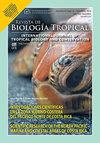First song description of the humpback whales, Megaptera novaeangliae (Balaenopteridae: Artiodactyla), breeding off Nicaragua
IF 0.6
4区 生物学
Q4 BIOLOGY
引用次数: 0
Abstract
Introduction: Humpback whales belonging to the Central American (CA) Distinct Population Segment breed off the Pacific coast of Nicaragua. Knowledge on this endangered population and its conservation status is limited. Objective: The aim of this study is to provide the first description of the CA humpback whale song off Nicaragua, which helps further understanding on the population’s dynamics. Methods: Acoustic recordings of songs were obtained during dedicated boat-based surveys at two locations on the Pacific coast of Nicaragua in 2018. Recordings were made from the boat using a portable system for a total of 23 hours and 56 minutes over 32 days from January to April 2018. A total of nine recordings of high enough quality for the song analysis were identified during this period from three different days at Padre Ramos (PR) (northern site) and four different days at San Juan del Sur (southern site). Song structure was described using standard humpback whale song elements, i.e. themes, phrases, and units. Results: A total of seven themes, seven phrases, and 19 unit types were identified. Three of the themes were common and frequently repeated in a song cycle while the others were less common in the repertoire and were recorded only during the middle of the season. Song theme order was variable, both within and across song sessions. Conclusions: This study provides the first song description of humpback whales along the Pacific coast of Nicaragua. Comparison of these songs with other datasets from the CA population and other breeding areas in the Northern Hemisphere could help understand the migratory patterns of these animals and the level of connectivity among populations since song can be socially learnt. Future data collection of humpback whale song recordings in Nicaragua is necessary to gain further understanding on the song structure variation within this population and the mechanisms of song transmission and dynamics across populations in the region.首首歌曲描述了在尼加拉瓜繁殖的座头鲸,Megaptera novaeangliae (balaenopterae:偶蹄目)
简介:座头鲸属于中美洲(CA)独特的种群段,在尼加拉瓜太平洋沿岸繁殖。对这一濒危种群及其保护状况的了解有限。
目的:本研究的目的是首次描述尼加拉瓜近海CA座头鲸的歌声,这有助于进一步了解该种群的动态。方法:2018年在尼加拉瓜太平洋沿岸的两个地点进行了专门的船只调查,获得了歌曲的录音。从2018年1月到4月,在32天的时间里,使用便携式系统在船上进行了23小时56分钟的录音。在此期间,在Padre Ramos (PR)(北部站点)和San Juan del Sur(南部站点)分别从3天和4天的不同时间内共鉴定了9段足够高质量的歌曲分析录音。歌曲结构使用标准的座头鲸歌曲元素来描述,即主题、短语和单元。结果:共鉴定出7个主题、7个短语、19个单元类型。其中三个主题是常见的,在一个歌曲周期中经常重复,而其他主题在保留曲目中不太常见,只在季节中期录制。歌曲的主题顺序是可变的,无论是在歌曲会话内还是跨歌曲会话。
结论:本研究首次对尼加拉瓜太平洋沿岸的座头鲸进行了歌声描述。将这些鸣声与其他来自北半球CA种群和其他繁殖区的数据集进行比较,可以帮助了解这些动物的迁徙模式和种群之间的连通性水平,因为鸣声可以通过社交学习。未来有必要收集尼加拉瓜座头鲸鸣声记录的数据,以进一步了解该种群内鸣声结构的变化以及该地区种群间鸣声传播和动态的机制。
本文章由计算机程序翻译,如有差异,请以英文原文为准。
求助全文
约1分钟内获得全文
求助全文
来源期刊

Revista De Biologia Tropical
生物-生物学
CiteScore
1.80
自引率
0.00%
发文量
23
审稿时长
4-8 weeks
期刊介绍:
The Revista de Biología Tropical / International Journal of Tropical Biology and Conservation is a mainstream scientific journal published since 1953 and covered by Web of Science; Science Citation Index; Current Contents; Google Scholar; Scopus, SciELO and nearly 50 additional indices.
A double blind system guarantees you a fair evaluation, and our world class editorial and scientific boards provides a first decision in three working days. The journal is Full Open Access and is widely read where your article can have the highest real impact.
Since its beginning in 1953, the Revista follows these principles: objective and independent evaluation of all manuscripts; transparency in all processes; ethical use of procedures, data, specimens and subjects; fair treatment of all parties; and absolute predominance of scientific rigor over any other aspect.
 求助内容:
求助内容: 应助结果提醒方式:
应助结果提醒方式:


